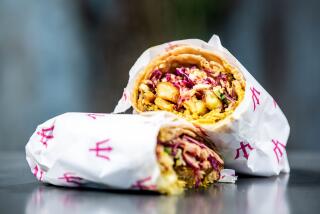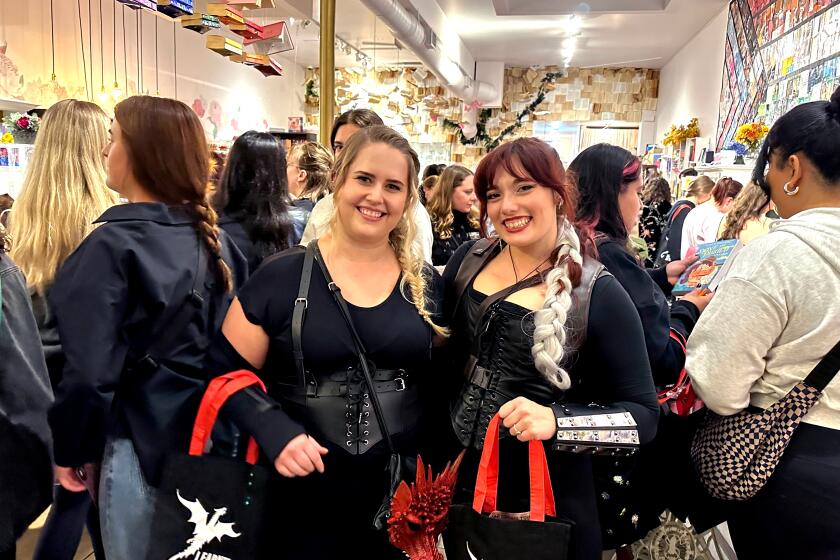Column: Trader Joe wrote a memoir, and it’s just as much fun as you’d expect
- Share via
There are two iconic pieces of signage in Los Angeles. One is big and tall and says “Hollywood,” the other is small and red and says “Trader Joe’s.”
For Angelenos, both are simply a part of the landscape, like the rearing heads of Mexican fan palms or strands of brake lights on the 405. Just as we groan when visitors want a Hollywood sign selfie —“Oh, my God. Why?”— we gasp when they say they don’t live near a Trader Joe’s —“Oh, my God. How?”
Can it honestly be called “life” if there is no Spiced Cider or two-buck Chuck? No Reduced-Guilt Mac & Cheese, Chocolatey Coated Chocolate Chip Dunkers or Crisp Pasadena Salad With Chicken? Who would choose to live somewhere you cannot buy TJ’s peanut butter-filled pretzels or Tempting Trail Mix, which is basically just candy?
It’s hard to think of any other market that holds so much sway over its customers, especially a chain with problematic parking and such a frankly bizarre inventory. How did a store that sells 15 kinds of dark chocolate and zero kinds of aluminum foil, a chain that proudly advertises popular items with limited availability, even come into being, never mind becoming wildly successful?
Founder Joe Coulombe will tell you exactly how in his posthumously published new memoir, “Becoming Trader Joe.”
In the early 2000s, decades after he had sold it to the German family that also owns Aldi’s, Coulombe wrote a “how I did it” history of Trader Joe’s, a chronicle of the clever end-runs, deep research and influences that powered the now-national chain. The tone is conversational, one man’s view of the world through the wine, spirit and grocery business, filled with the type of puns, literary references and bold-faced pronouncements that mark the store’s signage and its legendary promotional leaflet, the Fearless Flyer.
According to Patty Civalleri, who shepherded the book to publication, Coulombe did not imagine the book would ever be published; he wrote it simply to ensure there would be a record. In 2007, he gave it to original Trader Joe’s employee and longtime friend Leroy Watson, with instructions to do whatever he wanted with it.
Watson knew the Trader Joe’s story almost as well as Coulombe, but he had no idea what to do with a book. Eleven years later, he approached Civalleri, a friend who has published several travel guides, and asked her advice. “I read the book and fell in love,” Civalleri says. “Joe’s voice was in every sentence.”
So at Watson’s behest, and with Coulombe’s blessing, she edited the manuscript “for grammar and flow,” added some images and pitched it to her agent.
Coulombe died in the pre-pandemic days of 2020, which makes the publication of “Becoming Trader Joe: How I Did Business My Way & Still Beat the Big Guys” further proof of his energy and ingenuity: A year after his death, Coulombe is still telling us how it’s done.
Though clearly written for fellow entrepreneurs and business types — for all his folksiness, Coulombe had an MBA from Stanford — and published under HarperCollins’ Leadership imprint, “Becoming Trader Joe” is much more than a “how-to” guide. Moving from the 1960s to the 1990s, it is also a tour of California’s shifting economy and culture, guided by one of its most original thinkers.
As anyone who has ever enjoyed, say, TJ’s now-defunct Sir Isaac Newtons or the Bagel Spinoza might surmise, Coulombe drew inspiration from a breathtaking variety of sources. Ernest Hemingway, Buckminster Fuller, Barbara Tuchman, José Ortega y Gasset and the Whole Earth Catalog, not to mention the state Department of Alcoholic Beverage Control, all contributed in some way to a market that, in fighting the conformity of corporate brands, became one of the most famous brands of all.
Many Californians think they know the story of Trader Joe’s, or at least the important bits.
Coulombe, who remained personally involved in every aspect of the chain for years after he sold it, was always happy to discuss the two articles that revealed to him an emerging demographic: A 1965 Scientific American piece on how the GI Bill had dramatically increased the number of college graduates and a Wall Street Journal story from that same year announcing that the Boeing 747 would slash the cost of international travel.
Coulombe, trying to figure out how he could turn his struggling Pronto Markets around, decided that educated people who could now afford the trips they dreamed of might crave the type of products they associated with travel, also at prices they could afford.
In 1966, Coulombe writes, “The op-ed pieces in the LA Times fretted about how we would spend all that leisure time since the thirty-five-hour workweek was now a sure thing… so Trader Joe’s was conceived in an atmosphere of fun-leisure-party prosperity.”
The name and Tiki bar motif came from sources as varied as Disneyland’s Jungle Cruise, the songs “Yellow Bird” and “Beyond the Reef” and, of course, Trader Vic’s, then at the zenith of its Beverly Hilton glory.
Trader Joe’s became what we know and love in three major phases, which Coulombe identifies as “Good Time Charlie” (a party supply-heavy store complete with “girlie magazines”), “Whole Earth Harry” (hitting it big with bran and Brie) and “Mac the Knife” (when changes in California milk and alcohol policies forced Coulombe to move more deeply into TJ-brand food).
If there is a better description of Los Angeles’ evolution over those years, I don’t know one.
From the moment it begins at the Tail O’ the Cock on La Cienega Boulevard, Coulombe’s tale is a crazy-like-a-fox exploration of California culture through the lens of one wildly creative and well-read man always looking for a new way over, around or through. Entrepreneurs will no doubt find plenty of inspiration, but fans will find a fascinating origin story.
If nothing else, Trader Joe’s “normalized” previously outlier foods, from trail mix to frozen tacos. Did you know that for many years, TJ’s was one of the few markets offering extra-large eggs, almond butter, wild rice and real maple syrup? That it got into fruit and nuts, because the only local company that packaged bran insisted on shipping those as well? That Trader Joe’s was among the first grocery stores in the U.S. to accept credit cards and that in the early days, it had its own winery? In Cucamonga?
There were plenty of mistakes and misfires — Coulombe’s dream of building a store in one of Fuller’s geodesic domes didn’t pan out. He had to walk back claims that a Trader Joe’s brand of dog food was based on a formula devised at UC Davis (though the store still sells the no-corn kibble). And, as evidenced by the recent controversy over culturally modified brands including Trader Jose and Trader Ming, not all of the linguistic whimsy has worked.
But two things never changed: Inexpensive wine and well-paid workers. Coulombe devotes several chapters to the importance of paying workers well — minimal turn-over, fewer worries about unionization — which, given the current conflicts over raising the minimum wage, feels just as relevant as it did more than half a century ago.
And then there is the food. It’s hard to imagine a Whole Foods without the path cut by Trader Joe’s. More important, though many may argue about the names or even the quality of some of its offerings, TJ’s predicted — and helped create — the international and intercultural exploration that has redefined American cuisine.
For Civalleri, working on the book reminded her how big an imprint Trader Joe’s had on the culture of food. “Back in the ’60s and ’70s, our culture was all about processed food, canned food, homogenized brands. Joe found room to do something different. And that changed everything.”
Also, those peanut butter-filled pretzels.
More to Read
Sign up for our Book Club newsletter
Get the latest news, events and more from the Los Angeles Times Book Club, and help us get L.A. reading and talking.
You may occasionally receive promotional content from the Los Angeles Times.











